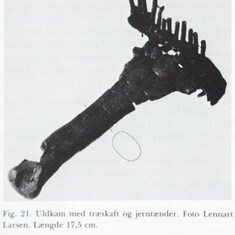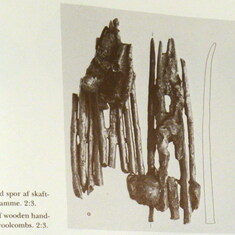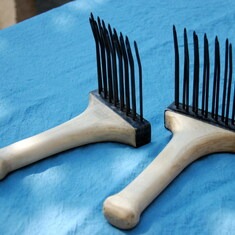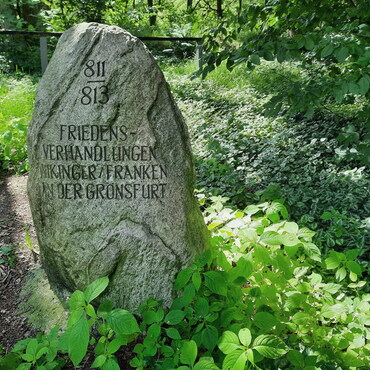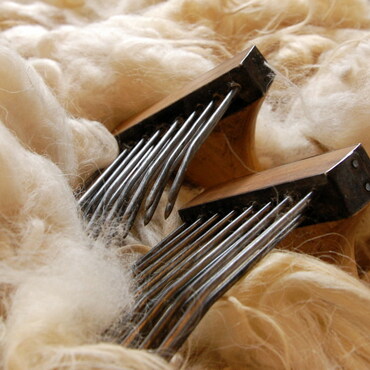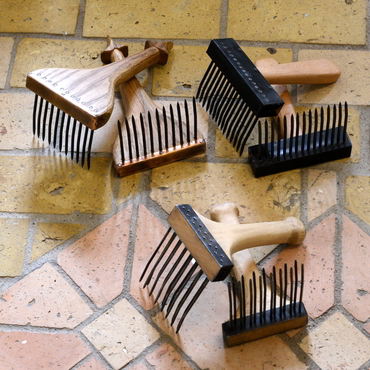The find
The description for this wool comb find (as well as the pictures in this post - except the one in the background of the title) are taken from "Fyrkat. En jysk vikingeborg II: Oldsagerne og gravpladsen." by Else Roesdahl (1977).
The remains of two wool combs have been found at the Danish fortress Fyrkat, which has been dated to the second half of the 10th century, at the outer side of a rampart at the site where a large fire has occurred in former times. One of the combs is almost complete, the charred handle made of lime wood (Tilia) fragmented, but still preserved. It is ca. 17.5 cm long, the head is 9.9cm wide. The handle gradually gets wider towards the head. The iron teeth, of which 14 survived, were driven through a 2.2cm wide iron sheet. Under the sheet, they protrude some 2.3cm. The iron sheet is broken off at one end and folded over the wood at the other. It is not certain whether the head is complete or not. No traces of a second row have been found on this comb, but it has been suggested that another collection of loose teeth might originally have belonged to it.
The other wool comb from Fyrkat is in a worse state than the first. Some 8cm of wooden handle close to the iron teeth are preserved and show that it had the same shape as the first comb. It too was made of Tilia. Apart from this, there are three loose collections of rusted iron teeth. The first tooth collection consists of wooden remains and 14 rounded teeth. The fragment is around 8cm wide. The best preserved teeth are slightly bent and 12cm long, but only 9cm are on the "upper" side of the iron sheet; 2cm are located inside the wood and another 1cm protrudes from the wood. The base of the teeth are broadened like a nail's head. It is not likely that the teeth would have been protruding 1cm at the underside of the comb when it was used and I guess that the wood simply shrunk due to the fire and perhaps the time lying in the ground. The second conglomeration consists of another five teeth and is ca. 3.2cm wide. A piece of wood is still attached to it. The third conglomeration of teeth suggests that the combs might have had two or more rows originally. It is not clear whether one of the loose tooth collections mentioned above might have belonged to the first comb.
The try to make a reconstruction
Vil made a reconstruction based on what we know and what we have. For the handle he used lime wood, just like in the original. For the teeth he used thick wire which he blackened (that was the best material available at the moment). Whether the metal sheet on the original was mounted the same way is impossible to say with only the pictures as a source. The measurements are as close to the original as possible. Vil decided to make a double teeth row. As mentioned above, it is not certain whether the original had only one or several rows.
The first impression of working with the combs is very positive. The way they lie in the hand feels quite good and they aren't too heavy. The real pro's and con's can, however, only be determined after many hours of working with these combs.
